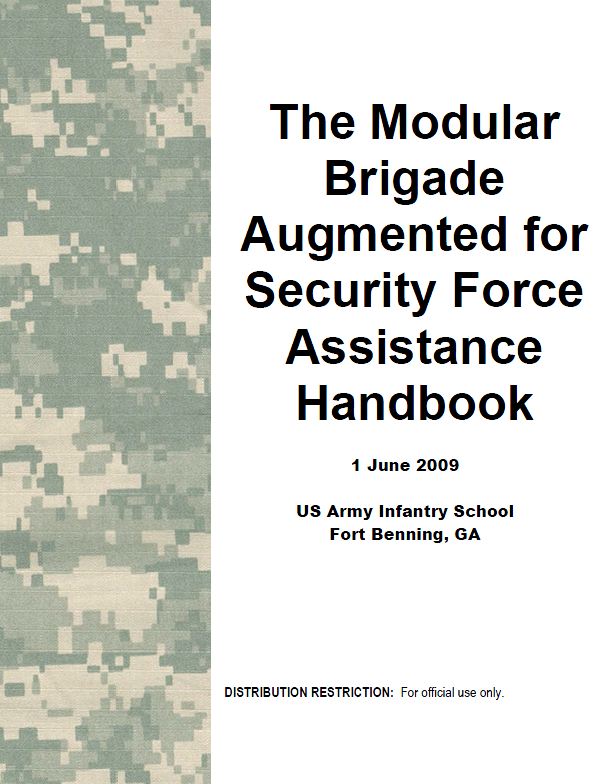The Modular Brigade Augmented for Security Force Assistance Handbook
- 32 pages
- For Official Use Only
- June 1, 2009
This hand book synthesizes current doctrine and emerging TTPs into a handbook for units assigned a Security Force Assistance (SFA) mission.
Security Force Assistance is not a unit; it is a mission assigned to a unit. Army leaders will assign this mission to Modular brigades more frequently according to the realities of the operational environment. The Modular Brigade, with its broad and flexible command and control structure, is designed to conduct Full Spectrum Operations, which includes Security Force Assistance, but it requires augmentation and specific task organization to effectively accomplish Security Force Assistance tasks.
The Modular Brigade Augmented for Security Force Assistance Handbook is designed as an assessment tool for brigade-level leaders as they prepare to train their BCT on the Security Force Assistance Mission. It serves as a guide for the most immediate challenges that Modular brigades will face, and as a catalogue of recently approved doctrinal literature available for commanders and staffs to access and apply.
Chapter One presents methodologies for task organizing and suggests a baseline augmentation that a BCT may require for an SFA mission. Chapter Two provides various assessment tools to evaluate the capabilities of Foreign Security Forces and to plan for their improvement. These assessment tools are drawn from current doctrine, operational units, professional journals and lessons-learned. Chapter Three describes how the BCT implements partnering, augmenting, and advising. Chapter Four summarizes how the BCT fits into the SFA strategic framework.
…
COMMONALITIES OF PARTNERING AND ADVISING
3-5. Partnering and advising share the core principles of empowering as well as working by, with, and through a FSF. The majority of FSA missions for BCTs will require combinations of partnering and advising with augmentation of FSF units or U.S. forces based on the situation. Unit partnerships do not replace advisor roles or functions. However, if partnering and advising are used in combination, it forms a three-part relationship among FSF, advisors, and the partner units. Partner units should look to the advisor to identify, shape, and facilitate operational partnering opportunities and training events. Both partner and advisor units must build rapport with, demonstrate their value to and have credibility with FSF leaders to varying degrees so that they can influence their counterparts to accomplish SFA missions. In short, units must be prepared to execute both tasks during an SFA mission because each task mutually supports the other and are often combined in multiple areas at the operational and tactical levels.
COMMON MAJOR CONSIDERATIONS OF PARTNERING AND ADVISING UNITS WHEN WORKING WITH FSF:
Plan
- Clearly define the mission and METL of the FSF.
- Define the end state for the period of partnering/advising.
- Define the advising concept. What are the advisor teams’ operational focuses in our AOR? Do they have an advising plan or a Campaign Plan they are helping the FSF employ based on the lines of effort?
- Define the partnering concept. How do we plan to partner with HNF? What does it mean to partner with a HNF?
- Determine if we require augmentation for our force. Do we plan to augment an FSF at some level?
- Define corruption. What are we prepared and capable of doing about it?
- Determine the key points of leverage that we can use to influence the FSF.
- Understand and define the security problem.
- Task-organize the force to secure advisors and maximize their operational capabilities with suitable enablers.
- Create, as needed, special elements in each force such as SWAT, waterway, border, or SOF.
- Establish mobile training teams.
Execute
- Ensure security forces understand they support the host nation (HN) government and the people.
- Maintain relevancy of security forces for their culture, their population, and their laws.
- Ensure credibility and legitimacy to all counterinsurgency operations.
- Provide a model for society by using military units of mixed ethnicity, religion, political affiliation. For example, who can work together to secure and protect all the people?
- Conduct combined operations with each newly trained security force; include them in the planning process.
- Promote mutual respect between U.S. and HN forces and between the military, police, and paramilitary.
- Train the trainers first, and then train the HN cadre.
- Support the HN cadre in training the whole force.
- Separate HN military and police forces, especially during their training.
- Place the HN cadre in charge as soon as possible.
- Recognize achievement, especially excellence.
- Train all security forces to not tolerate abuses or illegal activity outside of culturally acceptable levels.
- Develop procedures to report violations.
- Enable HN to assume the lead in counterinsurgency operations to alleviate effects of a large US presence.
- Ensure infrastructure and pay is appropriate and managed by the Host Nation government.
- Promote professionalism that does not tolerate internal incompetence. Develop methods to redress.

